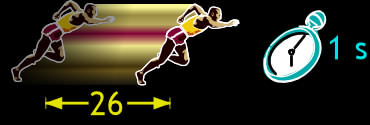Do bubbles in Guinness go
down?
The filming
You
can read more
about the background to the filming on the page about about the
authors.
Our initial attempts to video the bubbles in Guinness with a
regular video camera were all in
vain. The bubbles are just too small,
and too fast
to see
clearly. We borrowed a high-speed
digital camera (Kodak HS4540),
which is capable of taking up to 4,500 full frames in one
second. Below is a picture of the setup. The camera takes
the pictures and passes the images to the electronics box where they
are stored. These can then be recorded to VCR, or transferred as
digital images to the computer.

How small? How fast are
they?
 Most of the footage you can see on
this site was taken at 750 frames per
second, and is replayed at 25
frames per second - effectively slowing the bubbles down 30
times.
Most of the footage you can see on
this site was taken at 750 frames per
second, and is replayed at 25
frames per second - effectively slowing the bubbles down 30
times.
We used a zoom lens at around 6 times
magnification to see
the bubbles,
giving a field of view (size of the whole picture) of about 3 mm or
1/8" - about the same as the
width of two pennies.
What can we say about the size of the
bubbles?
We can measure them from the individual frames: see the picture
opposite. We find that they
are about 40
to 120 micrometers (1 to 4 thousandths of an inch) in
diameter. That
makes them roughly the size of human hairs (a human hair is roughly 100
micrometers wide).
And how fast are they
going? The time between the two frames below is 20 thousandths of
a second. The same single bubble has been circled in yellow at
both
times.

So the bubble
travels 0.422
mm (0.0166") in 0.02 s. At that speed it could
travel 2.11 cm (0.831") in 1 second, about 0.076 km (0.047 miles) per
hour, or about a mile a day!
Hold on a second! You said they were fast - right? 0.047 miles
per hour doesn't sound fast to me!
Yes, that's true. But we are mostly used to hearing about speeds
of things that are much bigger - like cars and planes. To put it
into perspective, let's see how our bubble stacks up against a 100 m
athelete. How wide (from front to back) is a 100 m runner?
Let's say 40 cm (16"). Our bubble is only 0.011 cm
wide (0.0043") - four thousand times smaller.
Our athelete does 100 m in 9.78 s, that is, 10.2 m in 1 s.
Compared to
his width, that's 26 body widths in 1 second. By comparison, our bubble
only does 2.11 cm in 1 second. But that's 192 times its own
diameter in
1 second - more
than 7 times better than our 100 m champion!


Acknowledgements
We
thank the EPSRC Engineering Instrument Pool for the loan of the Kodak
hi-speed digital camera equipment.
Back to
main page
(c) 2004 Alexander & Zare

 Most of the footage you can see on
this site was taken at
Most of the footage you can see on
this site was taken at 

